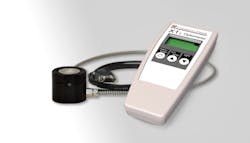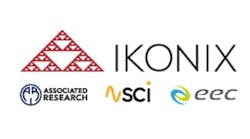Ultraviolet germicidal irradiation (UVGI) is a sterilization method that uses short wavelength light in the UV-C region (100 nm to 400 nm) to break down microorganisms such as viruses, bacteria, yeasts and fungi. The maximum effectiveness for germicidal activity is around 265 nm. The DNA and RNA of microorganisms absorbs the UV-C radiation, which causes changes in their structure rendering them unable to replicate. Microorganisms can be destroyed in a very short time if exposed to sufficiently high intensity UV-C radiation.
To ensure the germicidal effect, the UV dose must be checked. This is achieved by measuring the UV irradiance at the location of exposure using a UV radiometer.
In addition to checking the desired germicidal effect of high intensity UV radiation, the potential risk to skin and eyes from relatively low UV intensity must also be determined if there is the possibility of human exposure to the UV radiation. Carrying out both measurements with one device requires UV radiometers with a very large dynamic range.
Product description
UV-3726 Irradiance Detector for UV-C LEDs and low-pressure Hg lamps
The UV-3726 model offers all the properties and features of the UV-37 series detectors. They are specially designed for radiometric measurement tasks in the UV spectral region and have been proven in industrial and scientific use over many years.
The UV-3726 detector incorporates a photodiode that is only sensitive in the short-wave spectral range. In conjunction with additional optical filtering, only radiation in the specified spectral sensitivity range is measured. This combination enables the radiometric measurement of UV-C LEDs (Figure 2) and low-pressure mercury lamps (Figure 3). Selectable calibration factors for common UV LED wavelengths and low-pressure Hg lamps increase the measuring accuracy.
To measure the irradiance, the detector’s entrance optic is a diffuser with a cosine field of view, which must be positioned in the desired plane of measurement. The diffuser, optical correction filter and photodiode are pre-aged with UV radiation to significantly reduce the inevitable aging process that results from exposure to UV radiation. The UV-3726 detector shows very little aging effects even in intensive use. Any changes are recorded and corrected as part of the recommended annual recalibration.
The photodiode of the UV-3726 detector offers a strictly linear relationship between the measurement signal and the irradiance in the range from a few pico amps (10-12 A) to several micro amps (10-6 A). When connected to the Gigahertz-Optik X1-1-V02 meter (Figure 1) it provides a linear measurement range up to at least 100 mW / cm² with a resolution of 0.0001 µW / cm².
Calibration
Reliable measurements in absolute units require the calibration of the measuring device with traceability to national metrological institute (NMI) standards. Since 1993, the Gigahertz-Optik measuring laboratory has been accredited as a calibration laboratory by the PTB (Physikalisch-Technische Bundesanstalt) and the DAkkS (German Accreditation Body) for the measurement of spectral responsivity and spectral irradiance. Since then, all factory calibrations have been closely based on the calibration standards and quality management of the accredited calibration laboratory. Therefore, the factory calibrations of Gigahertz-Optik offer the highest possible level of traceability and have been accepted worldwide for many years.
In accordance with the requirements of individual industrial sectors, part of the measuring laboratory is accredited by the DAkkS as a DIN EN ISO / IEC 17025 test laboratory. As a result, Gigahertz-Optik can optionally offer a DIN EN ISO / IEC 17025 test certificate for the UV radiometer X1-1 with UV-3726 in addition to the factory certificate.
The UV-3726 detector is calibrated for its spectral responsivity. When performing a measurement, the nominal wavelength of the UV-LED or Hg lamp can be selected on the X1-1-V02 meter for highest precision. The meter offers several calibration options:
- An average calibration factor for measuring any UV LEDs in the spectral rangefrom 260 nm to 290 nm.
- A specific calibration factor for measuring low-pressure Hg lamps (at 254nm).
- Eleven, wavelength dependent, calibration factors given in 5 nm increments from 250 to 300 nm for measuring UV LEDs with known nominal wavelength.
Measuring device X1-1-V02
The X1-1-V02 measuring device evaluates the signal from the UV-3726 detector and displays the measured irradiance in absolute units, mW / cm². The high-quality signal amplifier of the meter supports the very large dynamic range of the detector and thus offers a measuring range of up to >100 mW / cm² with a resolution of 0.0001 µW / cm². In addition to the irradiance, the dose can also be displayed in J / cm². The measuring device offers a ‘peak-hold’ display function. The ergonomic housing of the device with its two AA batteries supports mobile use. Alternatively, the measuring device can be operated via its USB interface with the available application software for PCs. A software development kit (SDK) enables the measurement device to be integrated into user-written software.
Click here for more information.





